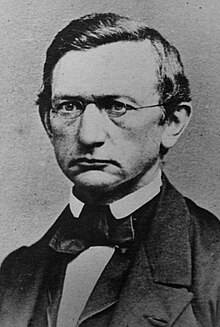Wilhelm Hillebrand (physician)
Wilhelm Hillebrand (in the USA also William Hillebrand ) (born November 13, 1821 in Nieheim , Westphalia , † July 13, 1886 in Heidelberg ) was a German doctor and botanist . Its official botanical author abbreviation is “ Hillebr. "
He was the father of the chemist William Francis Hillebrand .
Life
As the son of a judge, Hillebrand studied medicine in Göttingen , Heidelberg and Berlin . He was a member of the Corps Hanseatia Göttingen and Saxo-Borussia (1842). At the Friedrich-Wilhelms University doctorate he in 1844 to Dr. med.
From Paderborn to Hawaii
After graduating, he practiced as a doctor in Paderborn . Due to a lung disease, he was drawn to warmer climes. In 1849 he went first to Australia , then to the Philippines , where he also practiced as a doctor.
He moved on to San Francisco and (on the trail of Adelbert von Chamissos ) in 1850 to the Kingdom of Hawaii . Also active here as a doctor, he founded the Hawaiian Medical Association. King Kamehameha IV appointed him personal physician to the royal family in 1858. On his behalf, Hillebrand traveled to China , Hong Kong , Java and India with his wife and son William in 1865 to find workers for Hawaii's sugar plantations. So many Chinese and Portuguese came to the country.
Hillebrand founded charities and was involved in an immigration commission and in the fight against leprosy . King Kamehameha V , who had given the island kingdom a constitution in 1864, appointed Hillebrand to the Privy Council in 1865.
Homecoming
Hillebrand moved to Madeira and Tenerife in 1872, probably because of his unstable health . Returned to Heidelberg in 1877, he stayed in contact with Honolulu until 1880 . When the plans for a return became futile, he sold his property and the park to Thomas Foster, who gave the botanical garden its name.
botanist
Even before his time in Hawaii, Hillebrand was collecting plants. He discovered 250 new species. He brought crops such as the lychee to the archipelago , which are still grown profitably today.
Academic work
In 1871/72 Hillebrand lived in Cambridge , Massachusetts , in order to finish his work on the flora of Hawaii at the university there with the help of the Harvard botanist Asa Gray . He left dried seeds to the National Herbarium in Melbourne .
Foster Botanical Garden
In 1855 Hillebrand bought a two-hectare property in the middle of Oahu , which he made into the oldest tropical botanical garden with native and imported plants. A kapok tree has survived to this day. Before Hillebrand's death, Thomas Foster bought the garden, which he donated to the city of Honolulu in 1930. Its centerpiece is the orchid collection .
Honor taxon
In his honor, Veronica hillebrandii , Pheballium hillebrandii , Calamagrostis hillebrandii and the plant genus Hillebrandia (with the only species Hillebrandia sandwicensis in Hawaii) from the slate family (Begoniaceae) were named.
Works
- Flora of the Hawaiian Islands , 1888 (posthumous)
Individual evidence
- ↑ Kösener Corps Lists 1910, 72 , 32; 120 , 224
- ↑ Robert von Lucius in giant stone letter. 2010
literature
- Helmut Dolezal: Hillebrand, Wilhelm. In: New German Biography (NDB). Volume 9, Duncker & Humblot, Berlin 1972, ISBN 3-428-00190-7 , p. 148 f. ( Digitized version ).
- Richard Hess: Hillebrand, Wilhelm . In: Allgemeine Deutsche Biographie (ADB). Volume 50, Duncker & Humblot, Leipzig 1905, p. 339.
- Ursula H. Meier: Hawaii's Pioneer Botanist, Dr. William Hillebrand, His Life and Letters . Bishop Museum Press 2005. ISBN 9781581780475
Web links
- Literature by and about Wilhelm Hillebrand in the catalog of the German National Library
- Author entry and list of the plant names described for Wilhelm Hillebrand (physician) at the IPNI
- en: Foster Botanical Garden
- Melbourne Herbarium
- Veronica hillebrandii in the Germplasm Resources Information Network (GRIN), USDA , ARS , National Genetic Resources Program. National Germplasm Resources Laboratory, Beltsville, Maryland.
| personal data | |
|---|---|
| SURNAME | Hillebrand, Wilhelm |
| ALTERNATIVE NAMES | Hillebrand, William |
| BRIEF DESCRIPTION | German doctor and botanist |
| DATE OF BIRTH | November 13, 1821 |
| PLACE OF BIRTH | Nieheim , Westphalia |
| DATE OF DEATH | July 13, 1886 |
| Place of death | Heidelberg |
